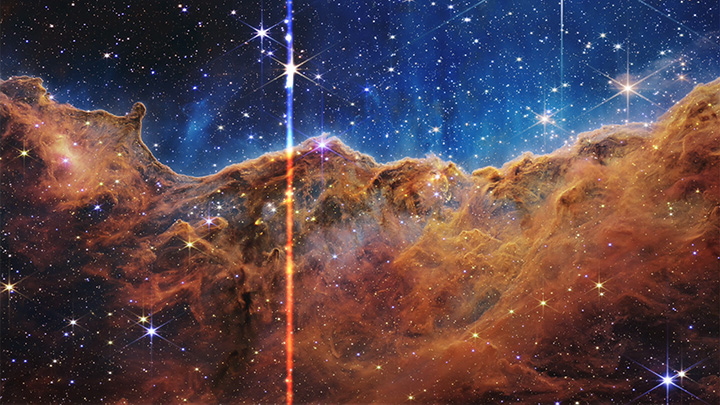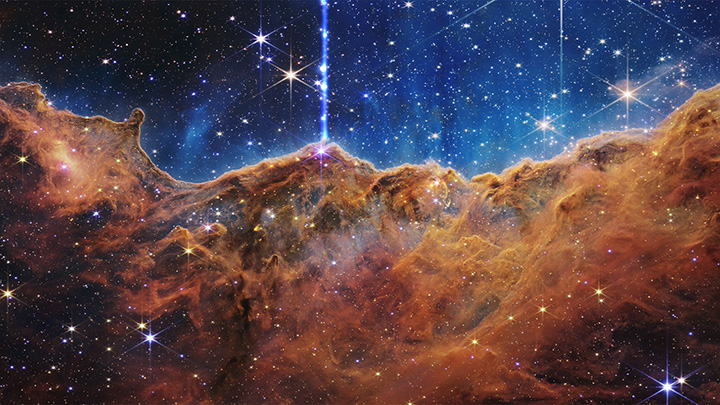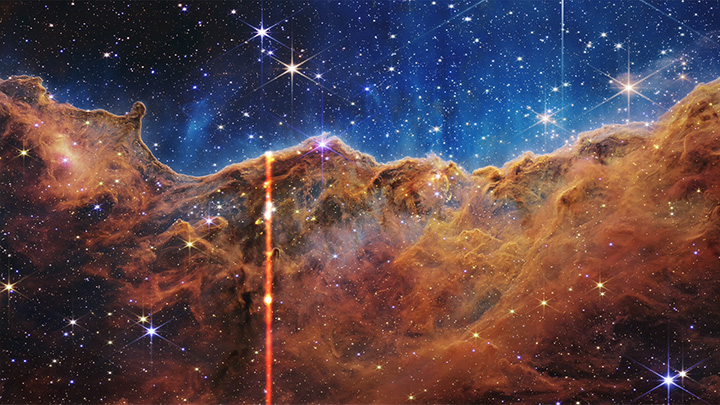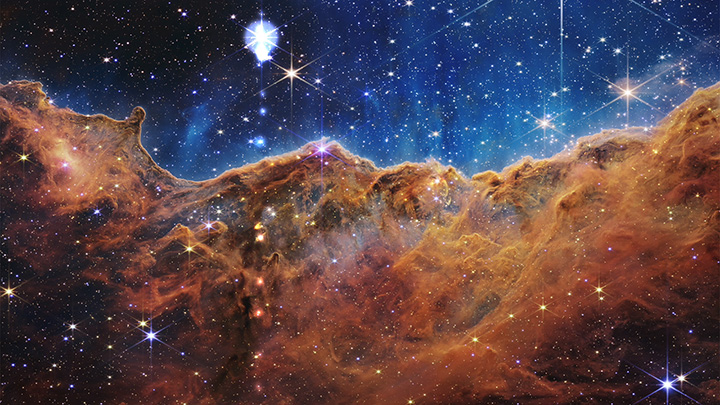
Carina Nebula Sonification
Video Description:
Sonifications map a near-infrared image of the Cosmic Cliffs in the Carina Nebula, captured by NASA’s Webb Telescope, to a symphony of sounds. Musicians assigned unique notes to the semi-transparent, gauzy regions and very dense areas of gas and dust in the nebula, culminating in a buzzing soundscape.
The sonification scans the image from left to right. The new sounds were also adapted to a video, allowing sighted viewers to watch as a vertical line moves across the frame.
The soundtrack is vibrant and full, representing the detail in this gigantic, gaseous cavity that has the appearance of a mountain range. The Carina Nebula is a large cloud of gas and dust where stars are forming or have already formed.
The gas and dust in the top half of the image are represented in blue hues and windy, drone-like sounds. The bottom half of the image, represented in ruddy shades of orange and red, has a clearer, more melodic composition.
Brighter light in the image is louder. The vertical position of light also dictates the frequency of sound. For example, bright light near the top of the image sounds loud and high, but bright light near the middle is loud and lower pitched. Dimmer, dust-obscured areas that appear lower in the image are represented by lower frequencies and clearer, undistorted notes.
The separate tracks below more easily pick out the meandering melodic line that represents the nebula’s “mountain range” as it rises and falls in the image, through the center of the frame, from left to right. This jagged line between denser and thinner areas of gas and dust is the arc of the sonification’s melody. All stars are represented by a combination of pitches and processed piano notes, but the brightest stars with longer diffraction spikes also carry crashes and clangs from cymbals.
Several files appear below for download: The first represents the entire image. The second only includes sounds from the top portion of the image, and the third file only includes sounds from the bottom half of the image. Listen to the second and third files to discern the “mountain top” feature in the image. A fourth file only plays the notes that represent stars. Listen to all of the tracks for a more complex understanding of how sounds were adapted to Webb’s image of the Cosmic Cliffs.
This sonification does not represent sounds recorded in space. Two musicians mapped the telescope’s data to sound, carefully composing music to accurately represent details the team would like listeners to focus on. In a way, this sonification is like modern dance or an impressionist painting — it converts Webb’s image to a new medium to engage and inspire listeners.
Explore Webb’s image of the Cosmic Cliffs, including its full text description, in more detail.
Access more information & file formats on this sonification
The Chandra sonifications were led by the Chandra X-ray Center (CXC), with input from NASA's Universe of Learning. The sustained collaboration was driven by visualization scientist Dr. Kimberly Arcand (CXC), astrophysicist Dr. Matt Russo and musician Andrew Santaguida (both of the SYSTEM Sounds project). For other sonifications, please see their linked pages.
cxcpub@cfa.harvard.edu
617-496-7941
60 Garden Street,
Cambridge, MA 02138 USA
Art Direction/Design: Kristin DiVona
Web Developers: Khajag Mgrdichian
& Kelly T.S. Williamson
Chandra X-ray Center, Operated for NASA by the Smithsonian Astrophysical Observatory. This site was developed with funding from NASA under contract NAS8-03060 | Privacy | Accessibility
Additional support from NASA's Universe of Learning (UoL). UoL materials are based upon work supported by NASA under award number NNX16AC65A to the Space
Telescope Science Institute, working in partnership with Caltech/IPAC, Jet Propulsion Laboratory, and Smithsonian Astrophysical Observatory.




